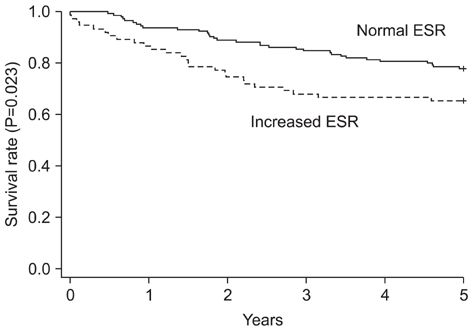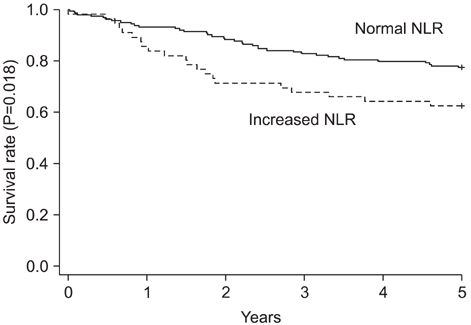J Gastric Cancer.
2013 Jun;13(2):111-116.
Clinical Significance of Preoperative Inflammatory Parameters in Gastric Cancer Patients
- Affiliations
-
- 1Department of Surgery, Inje University Seoul Paik Hospital, Seoul, Korea. cosmo021@hanmail.net
Abstract
- PURPOSE
Chronic inflammation induces cancer and cancer induces local tissue damage with systemic inflammation. Therefore, the aim of this study is to investigate the potential relationship between the severity of inflammation and prognosis in cancer patients.
MATERIALS AND METHODS
This study enrolled 220 patients from January 2002 to December 2006 who underwent gastric surgery. We evaluated the relationship between preoperative inflammatory parameters (erythrocyte sedimentation rate, neutrophil-to-lymphocyte ratio) and other clinicopathological factors. Survival outcomes were compared according to the extent of inflammation.
RESULTS
Significant elevation of erythrocyte sedimentation rate was related with old age, increased neutrophil-to-lymphocyte ratio, decreased hemoglobin, increased carcinoembryonic antigen, increased tumor size and advanced TNM stage. Neutrophil-to-lymphocyte ratio was significantly correlated with old age, increased erythrocyte sedimentation rate and advanced TNM stage. In the univariate analysis, elevated erythrocyte sedimentation rate and increased neutrophil-to-lymphocyte ratio had significantly poorer survival than those without elevation (all P<0.05). However, the multivariate analysis failed to prove erythrocyte sedimentation rate and neutrophil-to-lymphocyte ratio as independent prognostic factors.
CONCLUSIONS
The elevation of erythrocyte sedimentation rate and neutrophil-to-lymphocyte ratio were correlated with poor prognosis in the univariate analysis and there was a strong correlation between inflammatory parameters (erythrocyte sedimentation rate and neutrophil-to-lymphocyte ratio) and tumor progression. Thus, erythrocyte sedimentation rate and neutrophil-to-lymphocyte ratio are considered useful as follow-up factors.
MeSH Terms
Figure
Reference
-
1. Jung KW, Park S, Kong HJ, Won YJ, Lee JY, Seo HG, et al. Cancer statistics in Korea: incidence, mortality, survival, and prevalence in 2009. Cancer Res Treat. 2012. 44:11–24.
Article2. Coussens LM, Werb Z. Inflammation and cancer. Nature. 2002. 420:860–867.
Article3. Kuper H, Adami HO, Trichopoulos D. Infections as a major preventable cause of human cancer. J Intern Med. 2000. 248:171–183.
Article4. Yamashita H, Katai H. Systemic inflammatory response in gastric cancer. World J Surg. 2010. 34:2399–2400.
Article5. Lukaszewicz-Zając M, Mroczko B, Gryko M, Kędra B, Szmitkowski M. Comparison between clinical significance of serum proinflammatory proteins (IL-6 and CRP) and classic tumor markers (CEA and CA 19-9) in gastric cancer. Clin Exp Med. 2011. 11:89–96.
Article6. Kao SC, Pavlakis N, Harvie R, Vardy JL, Boyer MJ, van Zandwijk N, et al. High blood neutrophil-to-lymphocyte ratio is an indicator of poor prognosis in malignant mesothelioma patients undergoing systemic therapy. Clin Cancer Res. 2010. 16:5805–5813.
Article7. Jeong JH, Lim SM, Yun JY, Rhee GW, Lim JY, Cho JY, et al. Comparison of two inflammation-based prognostic scores in patients with unresectable advanced gastric cancer. Oncology. 2012. 83:292–299.
Article8. Hwang JE, Kim HN, Kim DE, Choi HJ, Jung SH, Shim HJ, et al. Prognostic significance of a systemic inflammatory response in patients receiving first-line palliative chemotherapy for recurred or metastatic gastric cancer. BMC Cancer. 2011. 11:489.
Article9. Nozoe T, Iguchi T, Adachi E, Matsukuma A, Ezaki T. Preoperative elevation of serum C-reactive protein as an independent prognostic indicator for gastric cancer. Surg Today. 2011. 41:510–513.
Article10. Chang CC, Sun CF, Pai HJ, Wang WK, Hsieh CC, Kuo LM, et al. Preoperative serum C-reactive protein and gastric cancer; clinical-pathological correlation and prognostic significance. Chang Gung Med J. 2010. 33:301–312.11. Mönig H, Marquardt D, Arendt T, Kloehn S. Limited value of elevated erythrocyte sedimentation rate as an indicator of malignancy. Fam Pract. 2002. 19:436–438.
Article12. Wang CS, Sun CF. C-reactive protein and malignancy: clinicopathological association and therapeutic implication. Chang Gung Med J. 2009. 32:471–482.13. Alao OO. Clinical utility of the erythrocyte sedimentation rate. J Clin Med Res. 2010. 2:119–124.14. Feldman M, Aziz B, Kang GN, Opondo MA, Belz RK, Sellers C. C-reactive protein and erythrocyte sedimentation rate discordance: frequency and causes in adults. Transl Res. 2013. 161:37–43.
Article15. Todorovic M, Balint B, Jevtic M, Suvajdzic N, Ceric A, Stamatovic D, et al. Primary gastric mucosa associated lymphoid tissue lymphoma: clinical data predicted treatment outcome. World J Gastroenterol. 2008. 14:2388–2393.
Article16. Wu Y, Fu X, Zhu X, He X, Zou C, Han Y, et al. Prognostic role of systemic inflammatory response in renal cell carcinoma: a systematic review and meta-analysis. J Cancer Res Clin Oncol. 2011. 137:887–896.
Article17. van den Tol MP, ten Raa S, van Grevenstein WM, van Rossen ME, Jeekel J, van Eijck CH. The post-surgical inflammatory response provokes enhanced tumour recurrence: a crucial role for neutrophils. Dig Surg. 2007. 24:388–394.
Article18. Ray-Coquard I, Cropet C, Van Glabbeke M, Sebban C, Le Cesne A, Judson I, et al. European Organization for Research and Treatment of Cancer Soft Tissue and Bone Sarcoma Group. Lymphopenia as a prognostic factor for overall survival in advanced carcinomas, sarcomas, and lymphomas. Cancer Res. 2009. 69:5383–5391.
Article
- Full Text Links
- Actions
-
Cited
- CITED
-
- Close
- Share
- Similar articles
-
- Preoperative Chemotherapy in Advanced Stomach Cancer (Cons)
- Clinical significance and prognostic value of C-reactive protein/albumin ratio in gastric cancer
- Significance of Preoperatively Determined CA 19-Serum Levels in Patients with Gastric Cancer
- Clinical Significance of Micrometastasis in Gastric Cancer
- Diagnostic Significance of the CEA, AgNORs and PCNA in the Gastric Dysplasia and Adenocarcinoma



